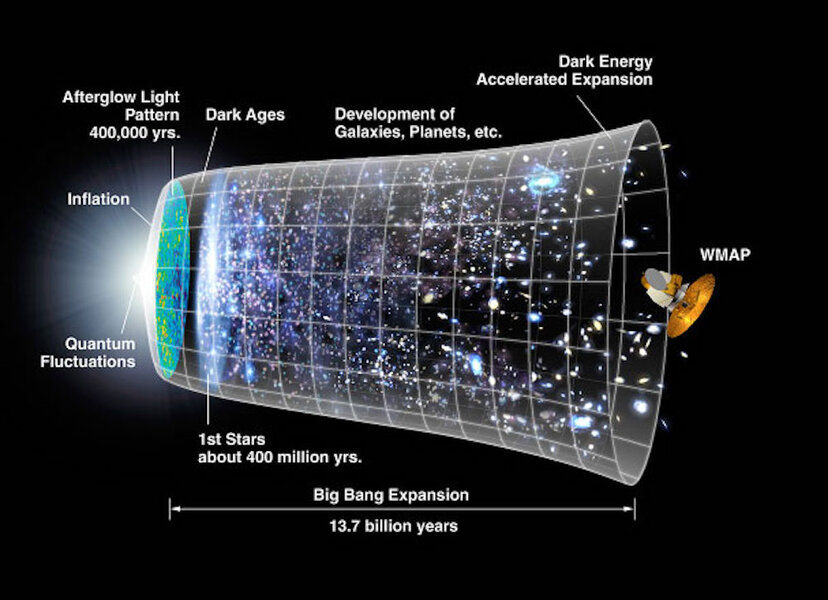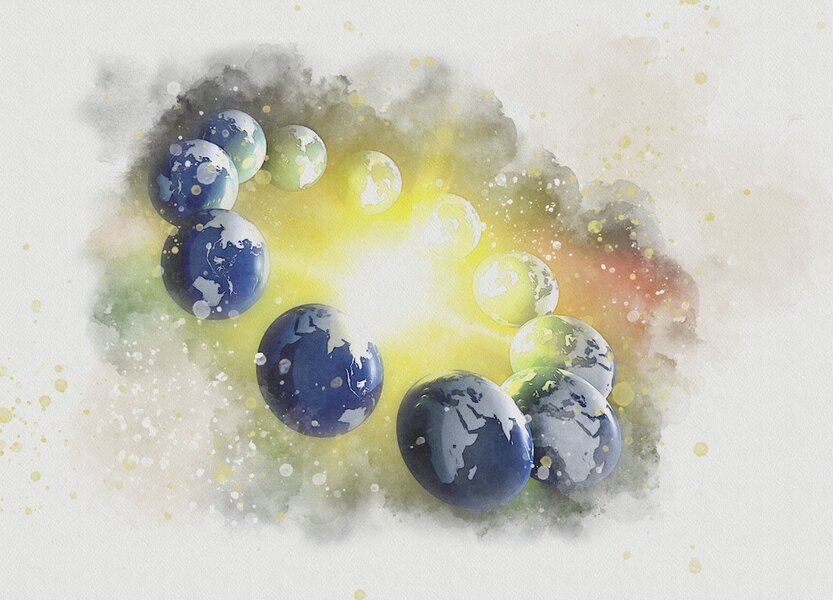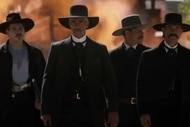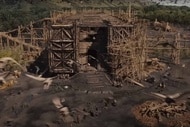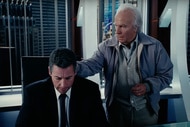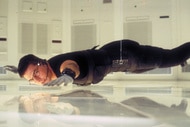Create a free profile to get unlimited access to exclusive videos, sweepstakes, and more!
The Truth About Pocket Universes: The Science Behind Donnie Darko
We might be living in a pocket universe right now!

Richard Kelly’s 2001 science fiction cult classic Donnie Darko (streaming now on Peacock) takes place almost entirely in an alternative timeline. The movie begins in the primary universe – what we would consider to be the “real world” – but splinters into a “tangent universe” on October 2, 1988, when Donnie (Jake Gyllenhaal) leaves home in the middle of the night at the behest of a humanoid rabbit just before a jet engine falls into his bedroom.
At the moment of fracture, the primary universe paused while Donnie and everyone else in existence continued totally unaware inside the tangent universe. The only evidence that anything was amiss was the presence of the jet engine which shouldn’t exist and a series of supernatural events occurring around Donnie and his neighbors. Donnie Darko is designed to be confusing, presenting events through Donnie’s eyes as they play out, without explaining the larger cosmic machinations at play. It’s also designed to insist upon repeat viewings and speculation.
Donnie Darko’s Temporary Tangent Universe
To make sense of what’s going on, over the years, fans have untangled the web of clues present on film, assisted by bonus materials in Kelly’s Director’s Cut including written pages of the fictional book, “The Philosophy of Time Travel.”
RELATED: Multiple Realities Aren’t Just Science Fiction Anymore
In the lore of the movie, tangent universes are said to be exceedingly rare eventualities which threaten all of existence. Once they emerge, they are highly unstable, capable of supporting themselves for only a few weeks before collapsing. Forces beyond our understanding choose a living receiver, Donnie, to return an Artifact (usually a metal object, like a jet engine) to the primary universe, thereby averting universal catastrophe.
The Living Receiver is assisted in his task by the Manipulated Living and the Manipulated Dead. The first group is larger, consisting of Donnie's family and friends, who unwittingly push Donnie toward his fate. The second group are smaller, consisting only of people who die in the Tangent Universe and are granted additional abilities to help guide the Living Receiver. It’s why Frank shows up to pull Donnie out of bed and warn him by saying, “28 days, 6 hours, 42 minutes, 12 seconds. That is when the world will end.”
Every Universe Might be a Pocket Universe, Including Our Own
In Donnie Darko, tangent universes are blessedly rare, but according to one cosmological model of reality, there might be an infinite number of them, including our own. We know from direct observation that the universe is expanding at an ever-increasing rate. Running the tape in reverse, reveals a universe shrinking into itself, vanishing into an infinitely dense point. The explosion of the entire universe out of that vanishingly small singularity is what we call the Big Bang, and it has incredible explanatory power in astronomy. But it doesn’t explain everything.
Our universe has a couple of characteristics which don’t make intuitive sense. First, because mass bends space time we expect the universe to have curvature, but it’s pretty much flat. Second, the average temperature of the universe, even among incredibly distant regions, is essentially even. If the universe had a constant rate of expansion the entire time, distant regions wouldn’t have had time to share heat and we should see a wider range of temperatures. Both of those problems can be solved by a brief but intense period of inflation in the early universe.
RELATED: How Christopher Nolan Saved Sci-Fi Cult Hit Donnie Darko From Purgatory 2 Decades Ago
One model of the early universe suggests there was an incredibly brief but impressive period of expansion during the first instances of existence. During that period the universe increased in size from something roughly a hundred billion times smaller than a proton to roughly the size of a beach ball. From there, expansion slowed down to more or less the rate we see today, allowing that beach ball of hot plasma to expand into the wide-ranging reality it is today.
That quick burst of inflation spread everything out evenly, like the three-dimensional equivalent of spreading a ball of warm dough flat. Inflation cleans up some of the gaps otherwise present in the Big Bang model but it has an interesting potential side effect. Namely that there might be an infinite number of universes blooming out of an eternally inflating cosmic seed bed.
In a 2007 paper, physicist Alan Guth made the case that the Bing Bang wasn’t the beginning but was only a beginning. In this model of existence, there is a sort of infinitely inflating cosmic fabric which occasionally blooms into what we would call a universe. While the definitions of time break down at this point, it does offer a potential answer to what there was “before” the Big Bang. Guth and colleagues suggest that exotic matter in the early universe created a temporary negative gravitational force, causing what we think of as the early universe to expand. Shortly, the exotic particle decayed into a bunch of conventional particles and the combined consequences of that event were the Big Bang. Guth shared the 2014 Kavli Prize in Astrophysics with Andrei Linde of Stanford University and Alexei Starobinsky of the Landau Institute for Theoretical Physics in Russia for pioneering the theory.
RELATED: New Study Finds People Follow Commands During REM Sleep
Guth also suggests that inflation never really stops, it only slows down in localized areas, creating universes in the process. Our universe can be thought of as a mushroom flowering from a great, expanding mycelium beneath the forest floor. A single mushroom might rise or fall but the system continues and new mushrooms (we’re talking about universes, you remember) are sprouting up all the time. If this view of reality is correct, it means that our own existence is just one pocket universe in an ever-expanding garden of pocket universes.
It also means that we’re living in a multiverse where, according to a 2007 paper published in Biology Direct, “the model of eternal inflation implies that all macroscopic histories permitted by laws of physics are repeated an infinite number of times in the infinite multiverse.” So long as the laws of physics don’t forbid it, there’s a universe where you are the Living Receiver. Maybe that’s this universe and you just don’t know it.
There’s also a universe where you’re watching Donnie Darko, streaming now on Peacock.
